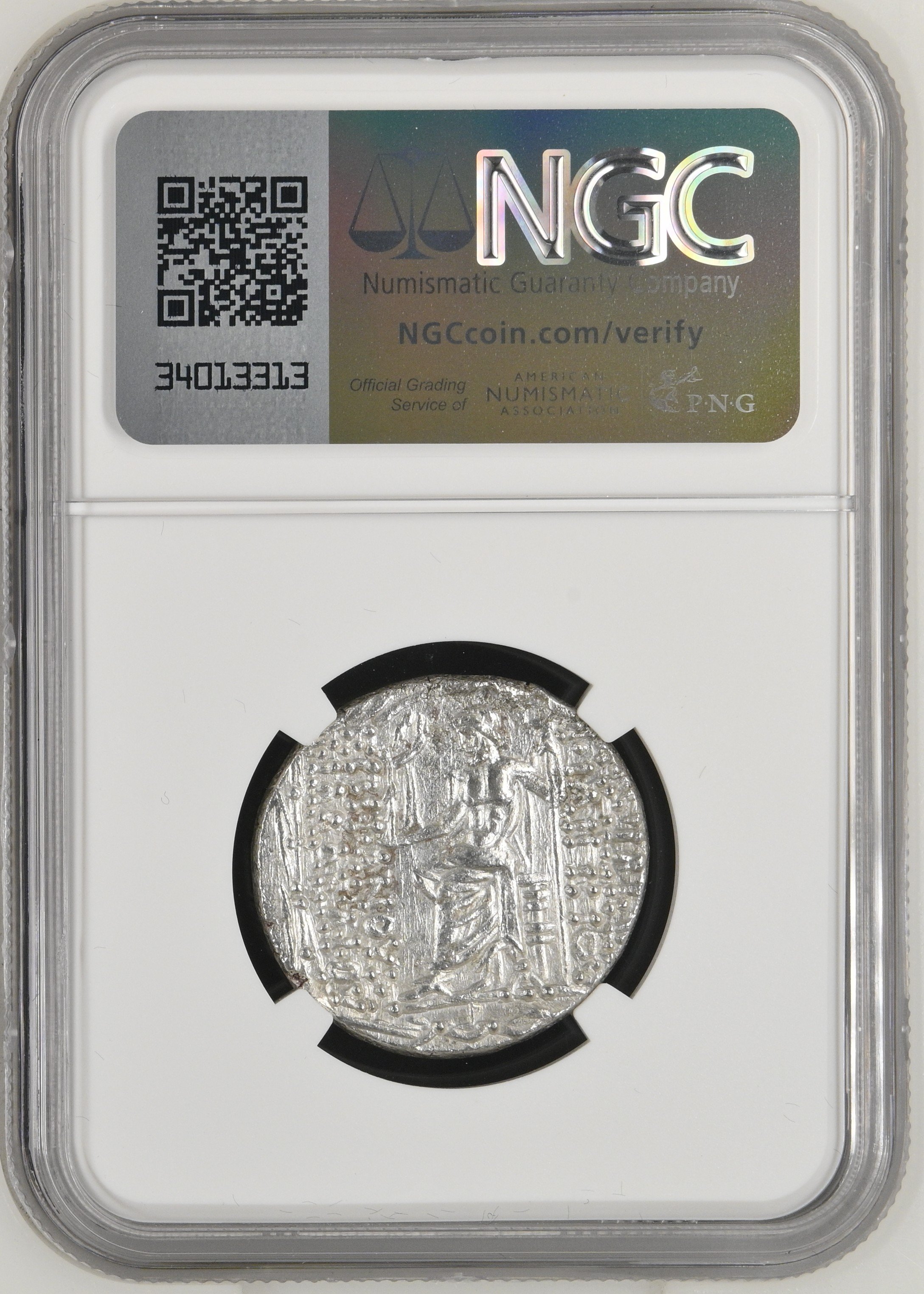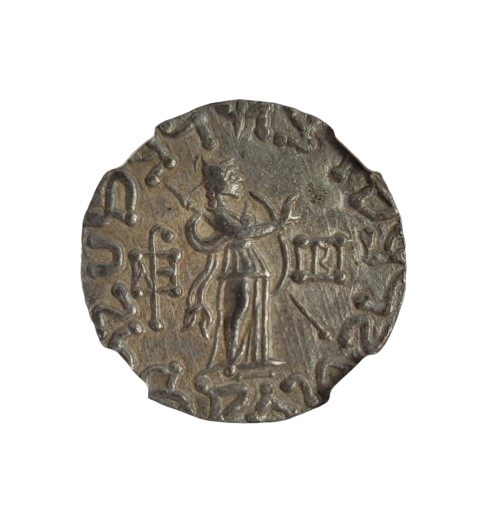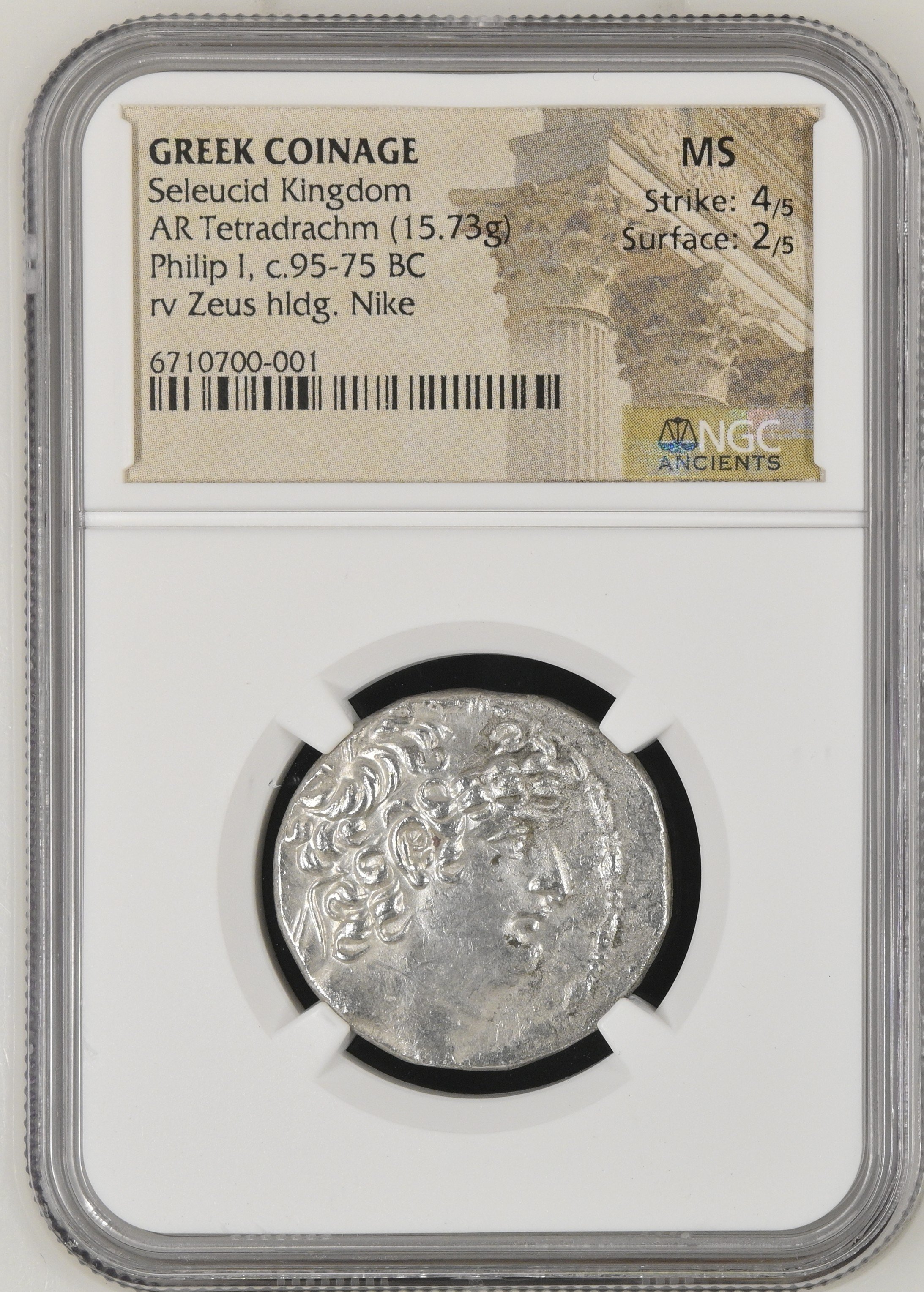 Image 1 of 5
Image 1 of 5

 Image 2 of 5
Image 2 of 5

 Image 3 of 5
Image 3 of 5

 Image 4 of 5
Image 4 of 5

 Image 5 of 5
Image 5 of 5






Silver Tetradrachm of Attalos I of Pergamon (about 2,250 years ago)
This silver tetradrachm was issued under King Attalos I of Pergamon, who ruled from 241-197 BCE, though it bears the name and image of Philetairos, the founder of the Attalid dynasty. Minted in Pergamon (modern Bergama in Turkey) around 241-235 BCE, this large silver coin represents the economic power and cultural sophistication of the Hellenistic kingdom of Pergamon, famous for its library, Altar of Zeus, and development of parchment.
Coin Description:
Front side: The obverse displays the laureate (wreath-crowned) head of Philetairos facing right, shown in idealized Hellenistic portrait style.
Back side: The reverse depicts Athena enthroned facing left, resting on a shield to her right, crowning the dynastic name with a wreath. Additional elements include a transverse spear in the background, a palm frond to the outer left, a monogram to the inner left, and a bow to the right.
Technical Details:
Silver composition (AR)
Tetradrachm denomination (equal to four drachms)
Weight: 17.04 grams
Size: 27mm in diameter
Die axis: 12h (when the coin is rotated along its vertical axis, the reverse is upright)
References: Westermark Group VIA, obverse die LXXXIX; SNG BN 1621
Date of minting: Circa 241-235 BCE (early in Attalos I's reign)
Historical Significance: This tetradrachm was issued during the early reign of Attalos I, who expanded Pergamon's territory and influence following his famous victory over the Galatians (Celtic settlers in central Anatolia). By continuing to feature Philetairos on his coinage rather than his own portrait, Attalos emphasized dynastic continuity and legitimacy. Pergamon was establishing itself as a major Hellenistic power and cultural center, developing important alliances with Rome that would shape Mediterranean politics for decades. The imagery of Athena, goddess of wisdom and warfare, reflected both the military successes and cultural aspirations of the kingdom, which would develop into a center of learning and art to rival Alexandria.
This silver tetradrachm was issued under King Attalos I of Pergamon, who ruled from 241-197 BCE, though it bears the name and image of Philetairos, the founder of the Attalid dynasty. Minted in Pergamon (modern Bergama in Turkey) around 241-235 BCE, this large silver coin represents the economic power and cultural sophistication of the Hellenistic kingdom of Pergamon, famous for its library, Altar of Zeus, and development of parchment.
Coin Description:
Front side: The obverse displays the laureate (wreath-crowned) head of Philetairos facing right, shown in idealized Hellenistic portrait style.
Back side: The reverse depicts Athena enthroned facing left, resting on a shield to her right, crowning the dynastic name with a wreath. Additional elements include a transverse spear in the background, a palm frond to the outer left, a monogram to the inner left, and a bow to the right.
Technical Details:
Silver composition (AR)
Tetradrachm denomination (equal to four drachms)
Weight: 17.04 grams
Size: 27mm in diameter
Die axis: 12h (when the coin is rotated along its vertical axis, the reverse is upright)
References: Westermark Group VIA, obverse die LXXXIX; SNG BN 1621
Date of minting: Circa 241-235 BCE (early in Attalos I's reign)
Historical Significance: This tetradrachm was issued during the early reign of Attalos I, who expanded Pergamon's territory and influence following his famous victory over the Galatians (Celtic settlers in central Anatolia). By continuing to feature Philetairos on his coinage rather than his own portrait, Attalos emphasized dynastic continuity and legitimacy. Pergamon was establishing itself as a major Hellenistic power and cultural center, developing important alliances with Rome that would shape Mediterranean politics for decades. The imagery of Athena, goddess of wisdom and warfare, reflected both the military successes and cultural aspirations of the kingdom, which would develop into a center of learning and art to rival Alexandria.
This silver tetradrachm was issued under King Attalos I of Pergamon, who ruled from 241-197 BCE, though it bears the name and image of Philetairos, the founder of the Attalid dynasty. Minted in Pergamon (modern Bergama in Turkey) around 241-235 BCE, this large silver coin represents the economic power and cultural sophistication of the Hellenistic kingdom of Pergamon, famous for its library, Altar of Zeus, and development of parchment.
Coin Description:
Front side: The obverse displays the laureate (wreath-crowned) head of Philetairos facing right, shown in idealized Hellenistic portrait style.
Back side: The reverse depicts Athena enthroned facing left, resting on a shield to her right, crowning the dynastic name with a wreath. Additional elements include a transverse spear in the background, a palm frond to the outer left, a monogram to the inner left, and a bow to the right.
Technical Details:
Silver composition (AR)
Tetradrachm denomination (equal to four drachms)
Weight: 17.04 grams
Size: 27mm in diameter
Die axis: 12h (when the coin is rotated along its vertical axis, the reverse is upright)
References: Westermark Group VIA, obverse die LXXXIX; SNG BN 1621
Date of minting: Circa 241-235 BCE (early in Attalos I's reign)
Historical Significance: This tetradrachm was issued during the early reign of Attalos I, who expanded Pergamon's territory and influence following his famous victory over the Galatians (Celtic settlers in central Anatolia). By continuing to feature Philetairos on his coinage rather than his own portrait, Attalos emphasized dynastic continuity and legitimacy. Pergamon was establishing itself as a major Hellenistic power and cultural center, developing important alliances with Rome that would shape Mediterranean politics for decades. The imagery of Athena, goddess of wisdom and warfare, reflected both the military successes and cultural aspirations of the kingdom, which would develop into a center of learning and art to rival Alexandria.
Mithridates or Mithradates VI Eupator (Ancient Greek: Μιθριδάτης;[2] 135–63 BC) was the ruler of the Kingdom of Pontus in northern Anatolia from 120 to 63 BC, and one of the Roman Republic's most formidable and determined opponents. He was an effective, ambitious, and ruthless ruler who sought to dominate Asia Minor and the Black Sea region, waging several hard-fought but ultimately unsuccessful wars (the Mithridatic Wars) to break Roman dominion over Asia and the Hellenic world.[3] He has been called the greatest ruler of the Kingdom of Pontus.[4] He cultivated an immunity to poisons by regularly ingesting sub-lethal doses; this practice, now called mithridatism, is named after him. After his death, he became known as Mithridates the Great.
Mithridates is the Greek attestation of the Iranic name Mihrdāt, meaning "given by Mithra", the name of the ancient Iranian sun god.[5] The name Mihrdāt itself derives from Old Iranian Miθra-dāta-.[6] The Greek-language epithet "eupator" (Ancient Greek: Εὐπάτωρ) means "of a well (noble) father",[7] and was adopted by a number of other Hellenistic rulers.
You Might Also Like











